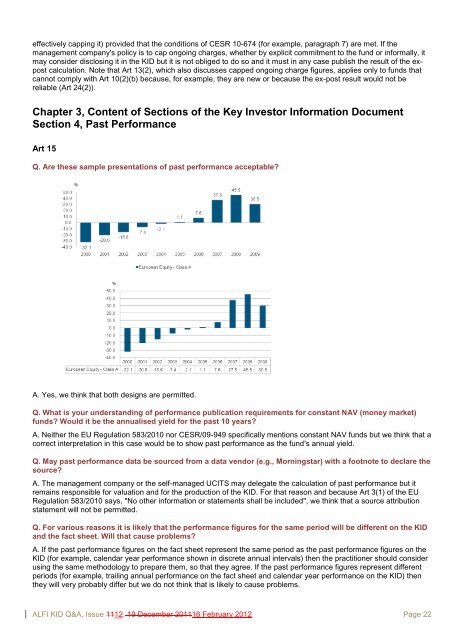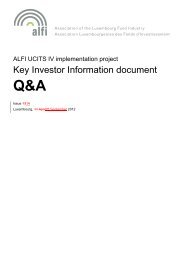Q&A - Alfi
Q&A - Alfi
Q&A - Alfi
Create successful ePaper yourself
Turn your PDF publications into a flip-book with our unique Google optimized e-Paper software.
effectively capping it) provided that the conditions of CESR 10-674 (for example, paragraph 7) are met. If the<br />
management company's policy is to cap ongoing charges, whether by explicit commitment to the fund or informally, it<br />
may consider disclosing it in the KID but it is not obliged to do so and it must in any case publish the result of the expost<br />
calculation. Note that Art 13(2), which also discusses capped ongoing charge figures, applies only to funds that<br />
cannot comply with Art 10(2)(b) because, for example, they are new or because the ex-post result would not be<br />
reliable (Art 24(2)).<br />
Chapter 3, Content of Sections of the Key Investor Information Document<br />
Section 4, Past Performance<br />
Art 15<br />
Q. Are these sample presentations of past performance acceptable?<br />
A. Yes, we think that both designs are permitted.<br />
Q. What is your understanding of performance publication requirements for constant NAV (money market)<br />
funds? Would it be the annualised yield for the past 10 years?<br />
A. Neither the EU Regulation 583/2010 nor CESR/09-949 specifically mentions constant NAV funds but we think that a<br />
correct interpretation in this case would be to show past performance as the fund's annual yield.<br />
Q. May past performance data be sourced from a data vendor (e.g., Morningstar) with a footnote to declare the<br />
source?<br />
A. The management company or the self-managed UCITS may delegate the calculation of past performance but it<br />
remains responsible for valuation and for the production of the KID. For that reason and because Art 3(1) of the EU<br />
Regulation 583/2010 says, "No other information or statements shall be included", we think that a source attribution<br />
statement will not be permitted.<br />
Q. For various reasons it is likely that the performance figures for the same period will be different on the KID<br />
and the fact sheet. Will that cause problems?<br />
A. If the past performance figures on the fact sheet represent the same period as the past performance figures on the<br />
KID (for example, calendar year performance shown in discrete annual intervals) then the practitioner should consider<br />
using the same methodology to prepare them, so that they agree. If the past performance figures represent different<br />
periods (for example, trailing annual performance on the fact sheet and calendar year performance on the KID) then<br />
they will very probably differ but we do not think that is likely to cause problems.<br />
ALFI KID Q&A, Issue 1112, 19 December 201116 February 2012 Page 22

















